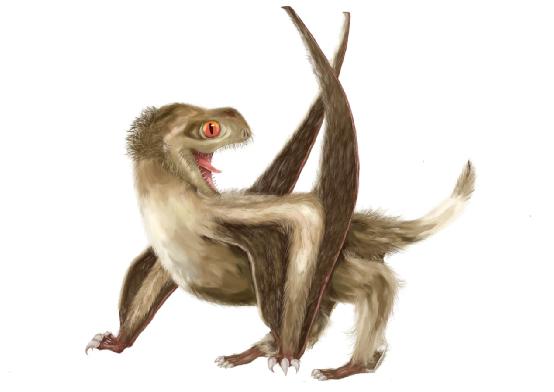Pterosaurs are the flying reptiles that lived side by side with dinosaurs from about 230 to 66 million years ago. Although pterosaurs have long been known to have a layer of fur covering the body, their hair structure was often thought to be very different from bird feathers.
In a paper published on December 17, 2018, in the online-only journal Nature Ecology and Evolution, a team of researchers from China, the United Kingdom, Ireland and Hong Kong, China, discovered for the first time four different types of feathers on anurognathid pterosaurs, including simple filaments (similar to "hairs"), bundles of filaments, filaments with a tuft, and down feathers. These four feather-like structures were previously found only in two major groups of dinosaurs -- the herbivorous ornithischians and the theropods (one branch of them evolved into birds).
This discovery pushes the origin of feathers back by some 70 million years.

A pterosaur reconstruction which shows four types of feather-like structures that cover different body parts. The reconstruction was drawn by Zhang Yuan, anundergraduate enrolled in 2017, at the School of Earth Sciences and Engineering, Nanjing University.
Professor Jiang Baoyu from the School of Earth Sciences and Engineering of Nanjing University, who led the research, noted: "We went to Inner Mongolia to do fieldwork in the Daohugou Formation, and we already knew that the sites had produced excellent specimens of pterosaurs with their pycnofibers preserved and I was sure we could learn more by careful study."
This study and the taphonomy of the Jurassic Yanliao Biota are the main research topics for PhD work of Yang Zixiao, from the School of Earth Sciences and Engineering.
"This was a fantastic opportunity to work on some amazing fossils," Yang said. "I was able to explore every corner of the specimens using high-powered microscopes, and we found many examples of all four feathers."
"Some critics have suggested that actually there is only one simple type of pycnofiber," said Professor Maria McNamara, one of the researchers of the study from the University College Cork, "but our studies show the different feather types are real. We focused on clear areas where the feathers did not overlap and where we could see their structure clearly. They even show fine details of melanosomes, which may have given the fluffy feathers a ginger colour."
"We ran some evolutionary analyses and they showed clearly that the pterosaur pycnofibers are feathers, just like those seen in modern birds and across various dinosaur groups," said co-author Mike Benton, a professor at the University of Bristol. "Despite careful searching, we couldn’t find any anatomical evidence that the four pycnofiber types are in any way different from the feathers of birds and dinosaurs. Therefore, because they are similar, they must share an evolutionary origin, and that was about 250 million years ago, long before the origin of birds."
Modern birds have two types of advanced feathers used in flight and for body smoothing, the contour feathers with a hollow quill and barbs down both sides. These are found only in birds and the theropod dinosaurs close to bird origins. Other feather types of modern birds, including monofilaments and down feathers, however, are widely found in dinosaurs and pterosaurs.
The armored dinosaurs and giant sauropods probably did not have feathers, which were likely prevented from growing, just as hair is suppressed in whales, elephants, and hippos. Pigs are also a classic example -- piglets are, like puppies, covered with hair, but the hair growth is then suppressed as they grow.
"This discovery has amazing implications for our understanding of the origin of feathers, but also for a major time of revolution of life on land," added Professor Benton.
"When feathers arose, about 250 million years ago, life was recovering from the devasting end-Permian mass extinction,” added Benton. “Independent evidence shows that land vertebrates, including the ancestors of mammals and dinosaurs, had switched gait from sprawling to upright, had acquired different degrees of warm-bloodedness, and were generally living life at a faster pace. The mammal ancestors by then had hair, so likely the pterosaurs, dinosaurs and relatives had also acquired feathers to help insulate them."
As the search for feathers in fossils has intensified in recent years, gaining understanding of their functions, especially the functions in such early forms, is imperative. Not only will this study change our understanding of a major revolution in life during the Triassic, but it will also deepen our understanding of the genomic regulation of feathers, scales, and hairs in the skin.
This study, conducted by Professor Jiang Baoyu's team, marked their third report on major research advances on the exceptionally preserved Mesozoic fossils in northeast China, following the reports in 2014 and 2017. This study was published in Nature Ecology and Evolution, and was supported by the National Natural Science Foundation of China and the Strategic Priority Research Program of the Chinese Academy of Sciences.
Article source: Yang, Z. X., Jiang, B. Y.,* McNamara, M. E., Kearns, S. L., Pittman, M., Kaye, T. G., Orr, P. J., Xu, X., & Benton, M. J.* 2019. Pterosaur integumentary structures with complex feather-like branching. Nature Ecology and Evolution (doi: 10.1038/s41559-018-0728-7).

